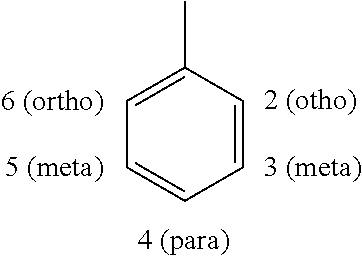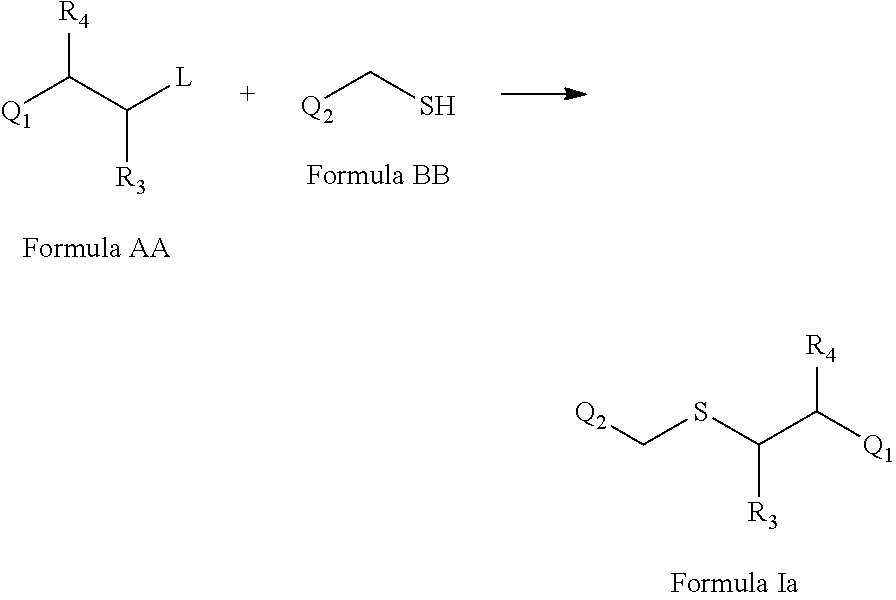Substituted alkyl diaryl derivatives, methods of preparation and uses
a technology derivatives, which is applied in the field of substituted alkyl diaryl derivatives, can solve the problems of adverse effect on the quality of time remaining, many cellular proliferative disorders have no available cures, and few, if any, treatment options to slow the progression of the diseas
- Summary
- Abstract
- Description
- Claims
- Application Information
AI Technical Summary
Benefits of technology
Problems solved by technology
Method used
Image
Examples
example 1
4-Chlorobenzyl-4-fluorophenethylsulfane
[0521]
[0522]The title compound was prepared according to Scheme 1. A solution of 0.01 mole sodium hydroxide in methanol 30 mL was taken in a 100 mL round-bottomed flask and cooled 10° C. To the cooled solution, 0.01 mole of 4-chlorobenzyl thiol was added slowly to the contents of the flask. A vigorous reaction occurred immediately. On completion of the addition and when the reaction was no longer exothermic, 1-(2-chloroethyl)-4-fluorobenzene (0.01 mole) was added portion wise, and the reaction mixture was stirred at room temperature for 3 h. The reaction was checked by TLC (thin layer chromatography) for completion. After completion, the reaction mixture was poured into crushed ice. The compound formed was filtered, washed with ice-cold water, and dried. The procedure according to General Procedure V produced the title compound with a yield of 90% and melting point 36-38° C.
example 2
1-Chloro-4-(((4-fluorophenethyl)sulfonyl)methyl)benzene
[0523]
[0524]The title compound was prepared according to Scheme 1. An ice-cold solution of 4-chlorobenzyl-4-fluorophenethylsulfane (4.0 g) in glacial acetic acid (25 mL) was added to a 100 mL round-bottomed flask. 30% hydrogen peroxide (8.0 mL) was added to the mixture at frequent intervals. Then, the reaction mixture was kept at room temperature for 24 h. The mixture was poured onto crushed ice. The solid formed was filtered, washed with ice-cold water, and dried. The procedure according to Reaction VI produced the title compound with a yield of 80% and a melting point of 142-144° C.
[0525]1H NMR (CDCl3, 300 MHz): δ 3.55-3.60 (m, 2H, CH2), 3.75-3.82 (m, 2H, CH2), 4.30 (s, 2H, CH2), 6.92-7.10 (m, 6H, Ar—H), 7.15 (d, J=8.1 Hz, 1H, Ar—H).). HRMS: m / z calcd [M+H] 313.69. found 313.40.
Scheme 2
General Procedures VII-XI are Used to Prepare Compounds 1-5 of Scheme 2.
[0526]
Non-limiting embodiments of reaction conditions for each step may...
example 3
2-Methoxy-5-(((2,4,6-trimethoxyphenethyl)sulfonyl)methyl)aniline
[0552]
[0553]The title compound was prepared according to Scheme 5. A solution of (E)-2-methoxy-5-((2,4,6-trimethoxystyrylsulfonyl)methyl)aniline (1.5 mmol) in a mixture of MeOH (60 mL) was treated with wet 5% palladium on carbon (50 mg) then exposed to a hydrogen atmosphere by using hydrogenation apparatus. After completion of the reaction (monitored by TLC), the reaction mixture was filtered through Celite, the Celite pad was washed thoroughly with methanol, and the filtrate evaporated under reduced pressure and dried under vacuum to obtain the title compound according to General Procedure XIX with a yield of 95% and had a melting point: 128-130° C.
[0554]1H NMR (CDCl3, 300 MHz): δ 2.98-3.04 (m, 2H, CH2), 3.08-3.15 (m, 2H, CH2), 3.80 (s, 2H, NH2), 3.81 (s, 6H, 2×OCH3), 3.82 (s, 3H, OCH3), 3.86 (s, 3H, OCH3), 4.13 (s, 2H, CH2), 6.13 (s, 2H, Ar—H), 6.76 (s, 3H, Ar—H). HRMS: m / z calcd [M+H] 396.14. found 396.12.
PUM
| Property | Measurement | Unit |
|---|---|---|
| cellular proliferative disorder | aaaaa | aaaaa |
| compositions | aaaaa | aaaaa |
| quality of time | aaaaa | aaaaa |
Abstract
Description
Claims
Application Information
 Login to View More
Login to View More - R&D
- Intellectual Property
- Life Sciences
- Materials
- Tech Scout
- Unparalleled Data Quality
- Higher Quality Content
- 60% Fewer Hallucinations
Browse by: Latest US Patents, China's latest patents, Technical Efficacy Thesaurus, Application Domain, Technology Topic, Popular Technical Reports.
© 2025 PatSnap. All rights reserved.Legal|Privacy policy|Modern Slavery Act Transparency Statement|Sitemap|About US| Contact US: help@patsnap.com



